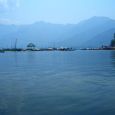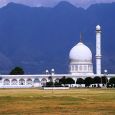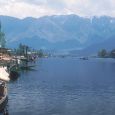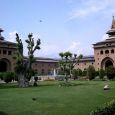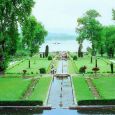Srinagar
Advertisement
By Air
Srinagar domestic airport is connected with many airports in major cities in India. Regular flights are operated between Srinagar and Delhi, Mumbai, Chandigarh and Shimla. International travelers get the connecting flights from Delhi International airport, which is at a distance of 876 km from Srinagar.
By Bus
Many tourist bus service providers arrange deluxe luxurious bus package tours from many neighboring cities to Srinagar. Srinagar is well connected to Chnadigarh (630 km), Jammu (290 km), Delhi (876 km), Leh (434 km) and Phalgan (96 km) by tourist bus services. Packaged tours charge about Rs 4 – Rs 5 per km.
By Train
Jammu is the nearest railway station to Srinagar, which is at a distance of 290 km. Jammu railway station is well connected to all major cities in India by rail. Direct train services are available from Delhi, Chennai, Bangalore and Trivandrum. Taxi services are available from Jammu to Srinagar and the fare is about Rs 6000.
Jama Masjid
The Jama Masjid of Srinagar is situated at Nowhatta, in the middle of the old city. An important mosque in Srinagar, it was built by Sultan Sikandar in 1400 AD. Later, the son of Sultan Sikandar, Zain-ul-Abidin got the mosque extended. The attractions of the Jama Masjid of Srinagar, Kashmir include beautiful Indo-Saracenic architecture, a magnificent courtyard and 370 wooden pillars. Another feature of the mosque is the peace and tranquility inside it, standing out against the hustle of the old bazaars around it. Thousands of Muslims assemble at the mosque every Friday to offer their prayers. This Jama Masjid of Kashmir, India has seen a number of destructions till date. It got ruined thrice in fire and was reconstructed every time. The last restoration was carried out during the reign of Maharaja Pratap Singh.
Dal Lake
Dal Lake has rightfully become an icon of the Kashmir tourism industry. A Himalayan urban lake, it has five basins and a number of channels that are well linked with each other. There are plenty of fishes in Dal Lake and fishery is the second largest industry of the region centered on the lake. The sparkling quiet waters of Dal surrounded by snow-capped mountains on its three sides, undoubtedly mark it as one of the most beautiful lakes of India. It is also the second largest lake in the State of Jammu and Kashmir with numerous gardens and orchards all along its shores. Houseboats form an indelible part of the scenery of the Dal Lake that are always ready to take tourists to a romantic and peaceful ride of the lake and soothe their nerves as the houseboat floats over the slightly rippling waters. They also offer some of the most exotic views of the splendid scenery of the Dal Lake.
There are Shikaras that look like small ornate versions of the gondolas of Venice that offers ferry rides to and from the banks of the lake to the houseboats. The shores of the Lake houses the distinct Moghul monuments and the campus of the Kashmir University while the two hillocks overlooking the lake house Shankaracharya and Hari Parbat temples. The glorious Mughal gardens on its shores contribute to the beauty of the Dal Lake. Out of about five hundred gardens laid down in 16th to 17th century, only a few still survive. There have been controversies about the origin of the Dal Lake. While some geologists believe that the origins of Dal Lake lie in the Pleistocene Oligotrophic Lake that once covered the entire valley of Kashmir, others just believe it to be a flood plain lake. The floating gardens of Dal Lake are considered a beauty in themselves. One can find a number of restaurants and hotels at the lakefront that have sprung up, encouraged by the large influx of tourists here.
Nishat garden
Nishat garden is the largest one of the Mughal gardens in Kashmir. It is situated on the banks of the picturesque Dal Lake. Also known as "the garden of bliss", the Nishat gardens have the Zabarwan Mountains forming its backdrop. Asaf Khan, the brother of Nur Jahan, designed the Kashmir Nishat Bagh in 1633 AD. Within the garden are ruins of some of the buildings dating back to the Mughal period. One of them is a double story pavilion enclosed on two sides with latticed windows. There is also a small spring behind the garden, known as Gopi Tirth. It is a source of supply of crystal clear water to the garden.
Nishat Bagh of Kashmir, India, offers a splendid view of the Dal Lake as well as the snow capped Pir Panjal mountain range. The garden has terraces, each representing a different Zodiac sign. There is also a beautiful water channel flowing right in the middle of the garden. Other attractions of the Nishat garden of Kashmir include its blooming flowerbeds, trees, fountains, etc. You can also take a shikara ride at the Nehru Park from the garden. A famous picnic spot, Nishat Bagh also offers shopping facilities to its visitors. There are a number of shopping stalls situated opposite the garden.
Hazratbal Mosque
Hazratbal Mosque is the most important Muslim Religious place, situated on the western shore of Dal Lake. Its pristine white marble elegance is reflected in the waters of the lake.
Hazratbal's special significance is derived from the fact that it houses a hair of the prophet Muhammad. This is displayed to the public on religious occasions, usually accompanied by fairs. Apart from these occasions, Friday prayers are offered at Hazratbal and attended by throngs of people. Hazratbal is remarkable for being the only domed mosque in Srinagar; the others having distinct pagoda like roofs. The shrine – mosque complex is situated on the western shore of the Dal Lake opposite Nishat Bagh and commands a grand view of the lake and the mountain beyond.
Wular Lake
Situated at a distance of fifty kilometers in Jammu and Kashmir, the Wular Lake is one of the largest fresh water lake in Asia and the largest lake in India. The cities of Sopore and Bandipore are located on the banks of the Wular Lake. The lake was formed as a result of tectonic activity.
Wular LakeThe lake is spread over an area of two hundred square kilometers, but the surface area of the lake varies from season to season. The Jhelum River evacuates into the lake at Babyari, which is forty kilometers downstream from Srinagar and again separates at Ningli. The floodwater of the Jhelum River acts as a natural reservoir.
In the northeastern side of the lake there are high mountain ranges. The deepest part of the lake is known as Mota Khon that means the `Gulf of corpses`. The artificial island of the lake is a famous picnic spot. The lake is the home to several migratory and resident birds and as many as fifty species of aquatic animals. The catchment area of the lake is covered with coniferous forests, alpine pastures and orchards, which adds to the scenic beauty of the lake.
The Lake is of immense significance to the people of the Kashmir Valley. In 1986 the lake was designated as a Wetland of National Importance under the Wetlands Programme of the Ministry of Environment and Forests, Government of India for the purpose of conservation and management. In 1990, it was assigned as a Wetland of International Importance under the Ramsar Convention.
April - June


